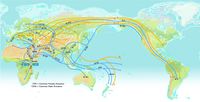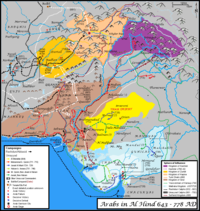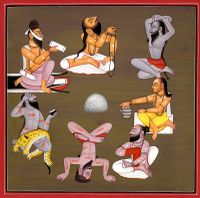Historical Racial Diversity of Hindus
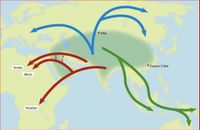
In the most ancient of Hindu scriptures, one can notice racial variations among the Vedic seers and communities of whom they write about. For example, Sage Kanva was explicitly noted as having been a "black rishi" ('krishna rishi') and "black" ('śyāma') while others' attributes can be known by their names, as Sage Asita Devala and his son Krishna Devala.
The Rigveda also mentions Arishtanemi, who is accepted as a Tirthankara in the Jain Dharma and he was black-skinned. Diversity of appearances ares appreciated, as can be seen from depictions of God/gods themselves. For example, Vishnu is usually shown blue, and Indra even says to him, "Dark blue Narāyaṇa clad in yellow, become four. "[1] Even Indra has no fixed color; mentioned as golden in the Rig Veda, but depicted as green and dark red in portrayals. Krishna and Rama are both described as 'nila-shyama-meghala'.[2]
The Karakoram and Kashmir regions that are known today for frequent occurrence of light skin was historically a place where dark skin prevailed. The Nisadas (tribals of ancient Karakoram) are described, "black like crow, very low statured, short armed, having high cheek bones, low-topped nose, red eyes and copper-coloured hair."[3] (The coppery hair is a result of the practice of using henna as nutrients for the hair. ) This is seen even from depictions of Tonpa Shenrab Miwoche as dark-skinned.
Many important persons, including those whom we now revere as devas were blackish or dark in color.
| On the right side is Yamaraja, holding a sceptre in his hand and seated on a water buffalo. He is the colour of black clouds when shaken by thunderbolts. | ||
—Mahavairocana Sutra | ||
Vedic Era[edit]
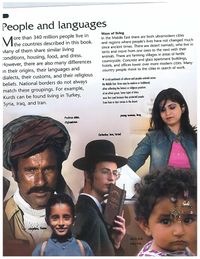
Misconception of the Dasas[edit]
"The Rgveda mentions sacrificers or generous patrons whose names do not appear to be Indo-Aryan, such as Śaṇḍa, Brbu, Araṭva Akṣa, and Balbūtha Tarukṣa. Such names suggest a process that brough various peoples into Vedic culture by giving them access to the ritual tradition."[5] - Stephanie Jamison
The Dasas were actually Turkic. They were a group of non-Indian invaders whom today have been identified by several scholars as the Dahae. In Indo-Iranian lexiconography, the Iranian languages' 'h' becomes an 's' in most Indian languages, and vice-versa. Hence, the Dahae/Dahau/Dahi become the Dasa of the Rig Veda, whom the Indian dynasties are in conflict with.
Whereas the Sanskrit word 'dasa' means servant, the patronyms Dahae/Daha/Dahi have no relation to an origin as 'dasa' and are in no way connected to servitude in any Hindu scriptures. The common misconception by many western writers, is that Dasas were an 'aboriginal' group India while the Rig Vedic writers themselves were outside of India.
The fact that Dasas were a national demographic and not a racial one, can be seen by Vedic seers writing of praying about the Dasas to become Arya. For example, Bharadwaj prays that Dasas become Arya. Hence, the possibility for a Dasa to become an Arya compatriot means the Dasas were a cultural population. Later on, many Dasas become Hindu. Social identifications of the Dasa have been 'anagnitra',[6] 'kravyad',[7] and 'anasa'.[8] In one passage, a chieftain referred to as "Dasa Balbutha Taruksha"[9] has been noted to have given gifts to Brahmanas. The Rig Veda also praises a Dasa chief for protecting Brahmanas.[10] In such ways, several foreign Dasas built bonds with the Arya communities thereby becoming a part of Indian societies. Hostility in the Avesta between Tuirya (Turks) and Airyā is indicated also in the Farvardin Yasht (10.37-8) but that some like the Tura Fryāna at King Vishtaspa’s court became Ariyā. Vasishtha calls himself a "dasa"[11] and says, "May I serve the god (Varuna) like a dasa, a lord." Further, the Yadu and Turvasa tribes were clearly Arya[12] but are called Dasa. It appears that several Dasa groups could not retain their Arya designation. Indra gets into conflicts involving the Dasyus and strips them of their Arya status and declares, "I have deprived the Dasyus of their appellation of Arya."[13] Manu Smriti further declares the border nations along the northwest of the Subcontinent as either Mlecchas or Arya-speaking Dasyus.[14]
That the Dasas were entering India is seen in Vedic passages, such as Rig Veda 2.11.18 wherein the "Dasyu were left in east while the Arya were enabled to march on."[15]
Turkic identity of the Dasas[edit]
That the Dasas were a Turkic nation can be seen by the name of Balbutha Taruksha, and 'Taruksha' is a term historically applied to Turkic groups, such as to Kanishka the Kushan monarch. Parthian Emperor Vardanes I is referred by Greek historian Tacitus to have conquered "tribes as far as the river Sindes, which is the boundary between the Dahae and the Arians."[16] As the river Sindes similar in name to the Sindhu, they are likely the same and so it again outlines the boundary between the Dasa and the Arya, wherein the Dasa reside west of the Sindhu and hence outside India. They were known to the writers in Balkh who had composed the Avestan Yashts[17] that wrote of their occupied lands as 'Dahinam' whereas those of Aryas were 'Airyanam' and of other Turks like the Dahae as 'Turiyanam'. The Videvdat further mentions the phrase, "anarya dahyus" when speaking of the Varena region.[18] Iranian legends, some compiled in the Shahnameh epic write of Turanians conflicting with Persians dynasties. These Turanians being invaders have been vilified and mentioned as Div Sefids,[19] and warriors who fought against them in the Shahnameh include Rustam, Bahram Gor, and Hushang. It is also noted that features of these non-Aryan divs include blue eyes[20] and blonde hair. Demonesses such as Al and Albarste were blondes. In the Pashtu legend of brothers Shudani and Budani liberating Kurram by the Indus River overthrow a Div Sefid or "Safad Dao" as well.
The Rig Veda also mentions the Turagama as a tribe to the north of King Bharata's empire, while the Turukas were northwest of it and the Tusharanas lived west of the Indus River.[21] It is noteworthy that these Dahae had left their mark in the regions that the inhabited within India. For example, in the Karakoram Mountains the exist place names, such as Dahoke Jagir, Dahok Khalsa, Dahara, Dahou Chak, and Dasgal.
Even after the Rig Vedic period, into the modern times, Turkic groups in India would play a role in politics. I'm addition to the Kushans and Hethphalites, there were additional Turkic kingdoms in the region. The Trakhan Dynasty of the Karakoram was one, and it had survived up to the Arab invasion. Tibetans, who had also ruled in the region applied the names Hor[22], Hor-Sok, Sok-pa, and Drugu for Turks. Even Karakoram's regional Mongols from the rulership under the Mongol Empire were called by Tibetans, Hor-po[23]. The Mon[24] are still a surviving group in the Karakoram, although they've adopted Indo-Aryan speech. Drukpa are a modern Shina-speaking group which claims ancestry from Alexander of Macedonia's army, and they also have Turkic background from their exonym 'Drukpa'. The 'Romaka Siddhanta' makes a reference to a country called Hungarai.[25] It also mentions Turashka, Turashkasthana, and Sakadesa.
Dasyus can be of any ethnicity[edit]
The word 'Dasyu' does not denote a connection to Dasa. It is not a specific ethnicity whereas Dasa actually refers to the Dahae nation. Dasyu is a term that has been applied to "raiders" and any threat of invasion or sedition by default is termed Dasyu.
The ten kingdoms that fought King Sudas in the Dasarajna War were ethnically all distinct from each other, some Arya and others not. They were Paktha, Turvasa, Druyu, Yaksu, Simyu, Matsya, Visanin, Alina, Bhalana and Bhrgu. Regardless of ethnicities, any threat to society is a Dasyu. Manu Smriti[26] declares "All people", outside of society, "whether they speak the Aryan or the Mlechcha languages are Dasyus." Hence, Dasyu-hood represents anti-sociality.
Many of the Dasarajna War's adverserial tribes were from the northwestern region outside of the Subcontinent. Historically they have always been labelled as Dasyu. The Manu Smriti[27] states that the Himalayas are the land of the Mlecchas, but that on the plains dwell the Aryans. In the Aitareya Brahmana, "Most Dasyus are from Vishvamitra."[28] The Mahabharata writes of the conquest by the Pandavas of "the Utsavasakatas, seven tribes of Dasyus inhabiting the mountains." Because of the similarities in grammar between the words within the Rig Veda, Dasyu, Dasa, Dasarajna, Trasadasyu, Sudas and a few others.
Dasyus becoming part of society[edit]
In the "Danastuthi" chapter of the Rig Veda, Dasyu, including non-Aryans, are praised for being generous towards priests by giving gifts. Making peace with King Sudas' kingdom was seen as virtuous.
The Pani chief Brbu is praised by Bharadwaj. As seen, Bharadwaj prays that Dasas become Arya. Balbutha Taruksha[29] has also been noted to have given gifts to Brahmanas. The Rig Veda also praises a Dasa chief for protecting Brahmanas.[30]
Racial identity of the Vedic writers[edit]
As Kanva was black-skinned, along with other identified writers, such as Ghora (whose name means dark), Dirghatamas (whose name means tall and dark), Asita (whose name means black) and Krishna (whose name means black), the scholarly Arya community was a diverse group of peoples. As these Vedic sages are from various gotras, it shows that people within all or many lineages had diverse physical traits."Golden colour" (hiranya varno[31], meaning yellow or light brown) for skin was normal too. Black hair was the only color[32] with devas and rishis applying soma juice to it.
Genetic marker R1A is a haplotype (ancestral identifier) which is been believed to be the common Indo-European trait. Its oldest subclades (i.e., R1A1A) have been found in Indian DNA. This gives further evidence for the Indian Subcontinent being the homeland of the Indo-European languages.
Even as far north as Kashmir and the Karakoram, in the Vedic times many people were very dark in color. The people by around Mt. Gandhamadana, are described as below.
| There, O king, the men are black and cheerful, endued with great strength and vigour, while the women are of the color of blue lotuses, and very beautiful. | ||
—Mahabharata Bhisma Parva Section 6 v.231 | ||
Integration of Indian Hindu migrants with Europeans[edit]
"India was the motherland of our race, and Sanskrit the mother of Europe's languages: she was the mother of our philosophy..." - William Durrant
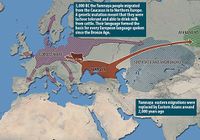
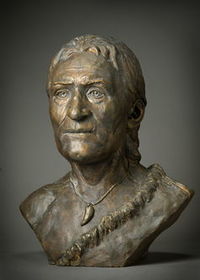
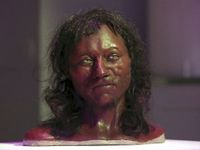
Also, “Sitting Woman”[36] in Sweden, and “La Brana 1”[37] in Spain, were both determined to be 7000yo and dark-skinned.
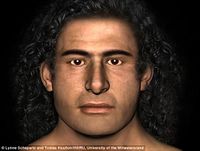
- See also: The spread of Hinduism, Danava
The peoples of the Vedic culture from India migrated out of the Subcontinent and mingled among many other ethnic groups. After eventually passing through modern-day Iran and reaching the Caucusus, they formed a nation by the southeast coast of the Black Sea that later be known as the Colchis. Herodotus, the Greek historian, thousands of years later at around 3rd century BCE upon seeing the Colchis described their appearance as "dark-skinned", comparing them to Egyptians[39]. However, Carl Ritter wrote that the Colchis were a colony from India. We know what the Egyptians looked like from the works of Xenophanes[40], Ammianus[41], Arrian[42], and Strabo[43], as well as others. We also know that the Colchis spoke an Indo-Iranian language because Apollonius of Rhodes and Diodorus of Sicily wrote Medea (personification of the Medians) spoke Colchian.[44] They had moved northwards to the north coast of and mingled among the natives to form (what today is labelled as) the Yamnaya culture. DNA testing has revealed that the Yamnayas were dark-haired, dark-eyed, people of color, and they found to have no mutations of lighter hair, eyes (SLC45A2), or skin (SLC24A5.)[45] These Yamnayas spread the Indo-Iranian languages throughout most of European through social integration and mingling. They lived in the Volga region.
The Sindi were a tribe among the Colchis. From them came the Kurds, and their traces are notable among the Kurds because Sindi is a common Kurdish surname. Those Sindi who had migrated to Yamnaya region and had produced the Yamnayas by having mixed with the European natives. These Sindi were also known as Maeotians. Karl Eichwald claimed that the Maeotians originated as an "Hindu" (Indian) colony. They lived in the Taman Peninsula and the adjacent coast of the Pontus Euxinus (Black Sea), in the district called Sindica, which spread between the modern towns of Temryuk and Novorossiysk.
While the Yamnayas were the descendants of the dark-skinned Indo-Iranians of the Caucasus mingled with native light-skinned Europeans, the Indo-Iranians that remained within the Caucasus became the Medians, who would in turn become the modern-day Armenians and Ossetians.
In Russia's Volga region during excavation, a 7th century AD Varaha statue was found in Staraya Maina village within the Ulyanovsk region[46] (this ancient area was highly populated city 1,700 years ago.) Ulyanovsk State University's archaeology department Dr. Alexander Kozhevin's team had made the discovery after having excavated the area. A famous Russian historian had written that thousands of years before the 'Kiev-Rus' culture (from which Russian nation originated) there was a 'Vedic-Rus' which was characterized by an international Vedic culture.[47] During the 14th century CE Indian gold coins were found in the Volga region near the village of Tenishevo, indicating a flourishing trade between India and Russia.
The Colchis that moved westwards by sailing across the Black Sea into the Balkans became the Thracians. They had given the river name 'Danube' because they were Danavas. The Thracians inhabited this region even before the earliest Greeks (Achaeans or Mycenaeans) made their way south to what is now called Greece.[48] Thracians even preceded Greeks to important islands in the northern, central, eastern, and eastern Aegean. This includes Thasos, Samothrace, Imbros, Lemnos, Euboea, Naxos, Lesbos, and Chios.[49]
The Indo-Europeans moved from Greece westwards and northwards. Historically, dark-skinned peoples have even been noted as far as the British Isles, such as people among the Pictish, as well as Silurians (ancestors of the Welsh and Cornish) who have received the misnoma 'Egyptian' and 'Ethiopian' even though they had spoken Indo-European languages. The Tuatha De Dananns among the nations of Ireland were the bringers of an Indo-European language to the island. They were Danavas whose Druid priests were the descendants of the Druyus, and this class of priests were spiritual leaders in British societies until Christianity dominated the isles. The Tuatha De Dananns have been noted in the 12th century Dindsenchas of The Book of Lecan as "the goodly dark race".[50]
Post-Vedic Era[edit]
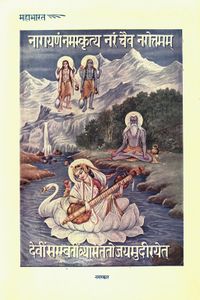
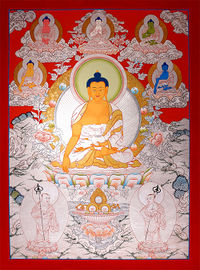
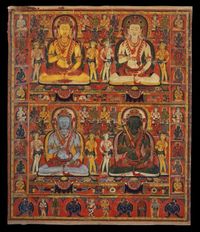
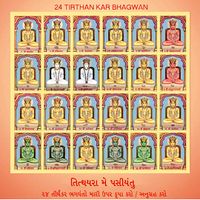
After the Vedic period, resulting from the integration of both Dasas and Indian groups, some Dasas had attained meritorious social positions. According to the Aitareya Brahmana, most of the dasyas are Visvamitra's descendants[51], and then in the Satapatha Brahamana, Indra refers to Vrtra as a Dasyu when he chastises Agni and Soma for supporting Vrtra against him.[52]
- Caste system had nothing to do with racial differences
In the Gautama Buddha's time period as well, there was a diversity of physical traits. Asita has been noted as a pious Brahman that was explicitly written of as "black-skinned" and his name indicates it. There was also another Brahman named Kanha (whose name means black) whom the Buddha debated with. The Buddha, in the Sonadanda Sutta, had once asked some Brahmans what the qualities of a Brahman are, and they had responded "varna, jati, mantra, sila and panditya." By "varna" they meant that they had to have been Brahman on both sides of their family for seven generations. By jati they meant that a Brahman can't be born ugly/deformed; by mantra, well-versed in Vedas; by sila, virtuous; and by panditya, well-learned.
The formation of castes began in this time period with many descendants in the lineages of rishis claiming to be Brahmans because of their ancestry to those sages. This can also be seen in the Buddhist Ambatsa Sutra wherein Ambatsa's gotra is linked with Kanha, who was not born a Brahman, and had achieved the status of a rishi by his studies but not by birth. His descendants such as Ambatsa had however claimed being Brahman just based on their lineage going back to the saint. This means that descendants of sages of various lineages had claimed Brahmanhood. Further, the Tibetan Buddhist tradition, the name 'Mahakala' has become a metaphor for a black-skinned Brahman servant of Tibetan Buddhist sage Nyen.[53]
- Various migrations into India
With time, more and more nations migrated into India, mainly with invasions. Apart from the Turanian nations from the Vedic Era that entered India as Dasas, the latter ones were other Turanians such as Kushans and Hethphelites (White Huns), as well as Europeans such as Greeks, Macedonians, and various Illyrian nations. From Alexandrian times there were also Dahae and Sakas that were mobilized into India as Alexander recruited armies outside of India but closeby in his Indian campaign. The Alexandrian Skythianus visited India in 50 CE.[54] His disciple Terebinthus had called himself a "Buddha". Ptolemy (Geog.1.17) talks of Greeks who had lived in the city of Madura "for a long time." Greeks living in such cities as Mauziris "penetrated inland and visited most of the native rulers at their courts."
Medieval Era[edit]
Even in South India, one can find peoples of many colors and other features similar within castes. There was never a time when castes varied according to physical traits. The Dalit poet Sivakkiyar himself writes, "that there is no difference between an outcaste and a Brahmin woman in flesh, skin or bones and that this may be experimented by simply sleeping with both of them."[55]
Modern Era[edit]
- Wrong translation of Sanskrit words and phrases into English
During the colonial era in the Indian Subcontinent, some writers with an agenda explored Hindu scriptures wrongly translated words and interpreted texts with racial connotations to suit their colonialist and Eurocentric context.
One can see the symbolism used in allegories. Utsavaiti Gatha: “Who is the religious man and who the impious? With whom of both is the black spirit and with whom the bright one? Is it not right to consider the impious man who attacks me or thee to be a black one ?” Here, “bright” and “black” are used figuratively to represent good and bad personal qualities.
| Sanskrit word | Colonialist translation | Actual meaning | Explanation of word |
|---|---|---|---|
| Anas | Noseless/Snubby-nose | Noseless/mouthless | Eurocentrists claim this as meaning "snubby-nosed" people (i.e., Australoids.) However, to have a "nose cut off" is even used in modern times to refer to people who have lost honor. The Rig Veda[56] also uses the words "handless" for Kunaru, and "feetless" for Vritra. Also, in Central India particularly "noseless" (gatanasika) is an insult as demonstrated in Seoni's sajni song.[57] |
| Dasa | Slave | Dahae | The Dahae were a Turkic group of peoples that originated in the Caucasus and had invaded the Iranian Plateau and had then invaded the Indian Subcontinent.
Although Dasa is a Sanskrit word, the Dasa ethnonym associated with a tribe in the Rig Veda refers to the Dahae. It is used out of context to refer to Servants by many writers. |
| Hiranyahasta | White-handed | Golden-handed | 'Hiranya' is always gold or golden and has never been applied to the color white. |
| Krishnayoni | Black people born of a black woman | Dark womb | 'Krishna' means dark and 'yoni' means womb. There is not a word or phrase in any Indian language that refers to certain phenotypes of people born of a womb. |
| Shuklavarna | White-skinned | White-colored / bright-colored / bright-qualitied | The Rig Veda mentions this phrase a few times but not in connection to
skin color. This term has been used in the context to spiritual class of people. A person can be both shuklavarna and krishnavarna, as Sage Agastya was because he worked as both a sage and a laborer.[58] Further, the The Vaishnavite ascetics of the chatuh sampradaya consider themselves to comprise a fifth varna, called the shukla varna, which is both separate from and superior to the four varna of householders.[59] This again demonstrates that shuklavarna is used mainly in personal, not physical, qualifies. |
| Suryatvac | Sun-white skin | Sun cover | Surya means the sun and tvac means cover. Nowhere in this Sanskrit word does white appear anywhere. |
| Svityanco | White | White-robed | The Vasishtas are known in various scriptures to wear white attire, as their official color. |
| Abhinila | Deep blue | Very dark | The Buddha's physical attributes include 'abhinila' eyes, meaning that his eyes are very dark (i.e., a very dark brown.) In the same scripture that mentions he has nila-colored eyes, also mentions of nila-colored monks. Clearly humans are not blue. The term "nila" is used in Buddhist scriptures for black as one can see that when Buddha's hair is described as "nilani".[60] Scriptures also elaborate on his eyes as "sitasita kamala dala sakala nayanah" ("the white portion of his eyes contrast with the black like petals of a lotus flower.") Tibetan kings trace their lineage to a son of Magadha who was born with "long blue eyebrows."[61] Bodhidharma was a monk with blue-eyes and is depicted as such, although the Buddha did not have blue eyes. The only temples in which Buddhas (not just Gautama) in which statues are depicted with various eye colors, are Tibetan ones. It's just a tradition among Tibetans to depict statues with eyes colors from yellow, to silver, blue, and green. The hair, lips, and eyes were painted with blue, red, and white pigments, to give the statue an animated expression. |
- Did castes ever give superiority to peoples of physical differences?
No. Just as in the Buddha's time wherein the closest castes ever gave physical preference was that a person not be physically deformed, but even that viewpoint was enforced or codified. Parshurama himself had accepted fishermen Sudras into Brahmanhood without requiring any physical requirement.
Even when foreign peoples settled in India, the new arrivals were arranged into caste sections and they required no particular physical attributes. They were brought into societal norms for Indians administrators to come to an agreement with these newcomers, who were usually invaders, that they can maintain their kingdoms within the Indian Subcontinent if they do not harm Indian civilians, respect Indian culture, and adopt the local language and religion. For example, the Gujjars were originally a Scythian group, and today there exist Gujjars of different castes including Gujjar-Gaur Brahmans, Gujjar Rajputs, and Gujjar tribals. Of the Sakas that entered India, there were people who became Sakadwipi Brahmans and Saka Rajputs. The Kokanasthas, who are descendants of ancient Scythians too were notarized to become Brahmans and Kshatriyas.
The only reason why in certain parts of southern India, one can sometimes see physical differences among castes is because the caste system was introduced by northern migrants to the southerners. This is why the frequency of Brahmans, Kshatriya, and Vaishya having light skin is higher than that of other castes. However, even this has gone unnoticed for the most part by locals. For example, the Tamil Harijan Sivakkiyar's poetry says caste has nothing to do with color.
"That there is no difference between an outcaste and a Brahman woman in flesh, skin or bones and that this may be experimented by simply sleeping with." - Sivakkiyar
Genetic Confirmation of Indigenous Aryans[edit]
“Plenty of people believe the Aryans came from Central Asia. But we have no evidence of that.” - Vasant Shinde, archaeologist and former Vice-Chancellor, Deccan College, Pune
Apart from the Rig Veda, which confirms that Aryans were fighting Turkic Dahae (Taruksha Dasa), genetics has proven a DNA link between the Indus Valley Civilization and Iranians 12,000ya.[62] This means that there was a link genetic connection between the Indians and Iranians and that it was not 'Steppes invaders' which brought some bloodline in both the Indian and Iranian plateaus which connect the two. This pre-Steppes-invader DNA is referred to 'Ancestral South Indian' (only because southern India is the only place where it is properly preserved) - not because it originated in southern India or because ancient Aryans did not possess this DNA.
The Steppes peoples and Indians with whom they intermarried had spread across the rest of India 2,000-1,000 BCE, whereas the Indus Valley Civilization arose prior to that period. This is consistent with period of the Rig Veda which mentions Dasas having become Aryans - the resulting peoples were primarily Danavas and Turvasus.
A 2019 report confirms[1] that the same genetics that peoples of the IVC possessed, is the basis for most modern Indians (not Steppes DNA being basis of North Indians while only southerners have the indigenous ancestry.)
“This breakthrough research completely sets aside the Aryan migration-invasion theory (which) is based on very flimsy grounds.”[63] - Vasant Shinde, archaeologist and former Vice-Chancellor, Deccan College, Pune
Apart from the false 'Aryan invader' narrative, it was also believed that some DNA common between Indians and Iranians was from farming communities that migrated into the Indian Subcontinent, giving rise to farming in India. The 2019 genetic report, as mentioned, confirms that the genetic connection between the Indian and Iranian plateaus go further back to 20,000 (before farming originated.)
See also[edit]
External resources[edit]
- THE RIGVEDA: A Historical Analysis By SHRIKANT G. TALAGERI
- "GET YOUR FACTS REICH Sorry Nazis, the swastika is 11,000 years old and INDIAN" By Jasper Hamill, 8th July 2016, 11:14 am
- "Himalayan Skeleton Lake Mystery Just Got Deeper" By ASHLEY COWIE, 21 AUGUST, 2019 - 18:00
References[edit]
- ↑ Ramayana By William Buck, B. A. van Nooten, Shirley Triest
- ↑ It means dark, black clouds.
- ↑ Bhāgavata Purāna IV.14. 44
- ↑ P. 12 The Middle East By Philip Steele
- ↑ P. 35 The Rigveda: A Guide By Stephanie Jamison
- ↑ It means without fire.
- ↑ It means flesh eaters.
- ↑ It means without honor or without good speech.
- ↑ Rig Veda 8.46.32
- ↑ Rig Veda 8.46.32
- ↑ Rig Veda VIII.86.7; "daso na milhuse karani"
- ↑ Rig Veda X.62.10
- ↑ Therefore, being Arya was a social designation. Rig Veda X.49.3
- ↑ P. 459 Between the Empires: Society in India 300 BCE to 400 CE edited by Patrick Olivelle
- ↑ Rig Veda 2.11.18
- ↑ Tacitus: Annales 11 Translated by Alfred John Church and William Jackson Brodribb (and edited by P. Swarney 2007)
- ↑ Farvardin Yasht 13.144
- ↑ Videvdat 3.17
- ↑ It means demons of white color.
- ↑ It is called as kubud chasham.
- ↑ P. 209 Asiatic Researches, Or Transactions of the Society, Instituted in Bengal By G. H. Huttman
- ↑ P. 201 Journal, Volume 2 By Royal Asiatic Society of Bengal, edited by James Princep
- ↑ P. 187 Art and architecture in Ladakh : cross-cultural transmissions in the Himalayas and Karakoram By Erberto F Lo Bue; John Bray
- ↑ It means descendants of Mongols.
- ↑ P. 339 Codices sanscritici By Professor Theodor Aufrecht
- ↑ Manu Smriti X.46
- ↑ Manu Smriti II.22.24
- ↑ P. 149 Uttarakhand: Past, Present, and Future By S. P. Agrawal
- ↑ Rig Veda 8.46.32
- ↑ Rig Veda 8.46.32
- ↑ Rig Veda 19.24.8
- ↑ "Black hair grow out of thy head like reeds" (Bk. VI.137.2)
- ↑ Modern Europe was formed by milk-drinking Russians: Mass migration brought new genetic make-up to continent 5,000 years ago By Sarah Griffiths and Jennifer Newton
- ↑ Ancient DNA reveals how Europeans developed light skin and lactose tolerance, June 10, 2015 3.21pm EDT, By Daniel Zadik
- ↑ "The first Brit? DNA suggests 10,000-year-old man found in cave had dark skin, blue eyes" BY THE ASSOCIATED PRESS ORIGINALLY PUBLISHED: FEB 7, 2018
- ↑ “Exclusive: This 7,000-year-old woman was among Sweden's last hunter-gatherers” By Kristin Romey (Published November 11, 2019)
- ↑ “Was this the first blue-eyed man? 7,000-year-old DNA reveals European and African traits“ By Daily Mail Reporter (Published 17:45 EDT 26 Jan 2014 , updated 08:31 EDT 27 Jan 2014)
- ↑ The face of Bronze Age fighter revealed: Scientists reconstruct face of the 'Griffin Warrior' who was part of an elite group 3,500 years ago By Stacy Liberatore and Shivali Best For Daily Mail
- ↑ P. 393 Herodotus, Volume 1 By Herodotus
- ↑ "Black people resided not in the Nile Valley but in a far land, by the fountain of the sun."; Hesoid: Works and Days 527-8
- ↑ "The men of Egypt are mostly brown and black with a skin and desiccated look."; Ammianus Marcellinus
- ↑ "The appearance of the inhabitants is also not very different in India and Ethiopia: the southern Indians are rather more like Ethiopians as they are black to look on, and their hair is black; only they are not so snub-nosed or woolly-haired as the Ethiopians; the northern Indians are most like the Egyptians physically."; Indica 6.9 By Lucius Flavius Arrianus
- ↑ "As for the people of India, those in the south are like the Aethiopians in color, although they are like the rest in respect to countenance and hair, whereas those in the north are like the Egyptians."; Strabo Geography 15.1.13
- ↑ Medians spoke Colchi language: Apollonius of Rhodes and Diodorus of Sicily wrote that Medea had spoken Colchi. Medea, Chalciope, and Apsyrtus had spoken Colchi.; P. 205 Stones that Speak By Robert D. Morritt
- ↑ Sandra Wilde (2014). "Direct evidence for positive selection of skin, hair, and eye pigmentation in Europeans during the last 5,000 y". PNAS. 111. doi:10.1073/pnas.1316513111
- ↑ Ancient Vishnu idol found in Russian town, Jan 4, 2007, 11.09 AM IST
- ↑ India’s Emerging Partnerships in Eurasia: Strategies of New Regionalism By Dr. Nivedita Das Kundu
- ↑ P. 37 Chronicles, Volume 21 By Rockford Institute
- ↑ The Rise Of The Greeks By Michael Grant
- ↑ P. 290 “The” Towers and Temples of Ancient Ireland: Their Origin and History Discussed from a New Viewpoint By Marcus Keane
- ↑ Aitareya Brahmana 7.18
- ↑ Satapatha Brahamana 1.6.13
- ↑ P. 94 Reading Asian Art and Artifacts: Windows to Asia on American College Campuses By Paul Nietupski, Joan O'Mara
- ↑ The Shape of Ancient Thought: Comparative Studies in Greek and Indian By Thomas McEvilley
- ↑ P. 36 The Mission and Message of Ramalinga Swamy By T. Dayanandan Francis
- ↑ Rig Veda III.30.8; P. 99 Monsters and the Monstrous in Medieval Northwest Europe edited by Karin E. Olsen, L. A. J. R. Houwen
- ↑ P. 578 'Semiotica Indica: Encyclopaedic Dictionary of Body-language in Indian Art & Culture, Volume 2 By Hira Lal Shukla
- ↑ P. 37 Vedamrut By Vinoba Bhave
- ↑ P. 46 The Conditions of Listening: Essays on Religion, History, and Politics in South Asia By Richard Burghart; Ram Patal: 32-48
- ↑ ‘Uddhaggani lomani jatani nilani anjanavannani kundalavattani padakkhinavattaka jatan’ (D.II,17)
- ↑ P. 103 Sainik Samachar: The Pictorial Weekly of the Armed Forces, Volume 35 By India
- ↑ "An Ancient Harappan Genome Lacks Ancestry from Steppe Pastoralists or Iranian Farmers" By Vasant Shinde, Vagheesh Narasimhan, Nadin Rohland, Swapan Mallick, Matthew Mah, Mark Lipson, Nathan Nakatsuka, Nicole Adamski, Nasreen Broomandkoshbacht, Matthew Ferry, Ann Marie Lawson, Megan Michel, Jonas Oppenheimer, Kristin Stewardson, Nilesh Jadhav, Yong Jun Kim, Malvika Chaterjee, Avradeep Munshi, Amrithavalli Panyam, Pranjali Waghmare, Yogesh Yadav, Himani Patel, Amit Kaushik, Kumarasamy Thangaraj, Matthias Meyer, Nick Patterson, Niraj Rai,5, and David Reich (Published: Published online: September 5, 2019)
- ↑ "Indology after Rakhigarhi: How DNA is demolishing the Aryan Invasion Theory" By Rakesh Krishnan Simha (Published: November 9, 2019)

